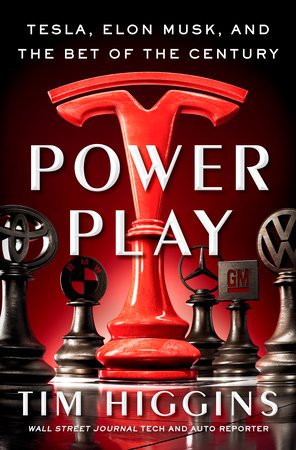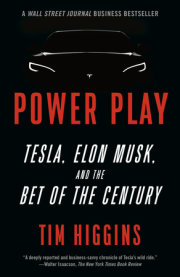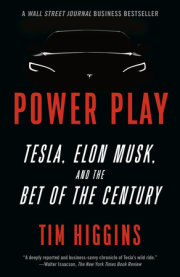Chapter 1
This Time Could Be Different
The idea for an electric car kept JB Straubel up late one summer night in 2003. His tiny, rented house in Los Angeles brimmed that evening with members of Stanford University’s solar car team, who had just finished a race from Chicago. The biennial event was part of a growing movement to stoke interest among young engineers in developing alternatives to gas-powered vehicles. Straubel had offered to play host to his alma mater’s team, and the grueling run left many sleeping on his floor.
Intensely focused on his own projects, Straubel had never joined the team himself during his six years at the Stanford engineering school. But his interests aligned with those of his guests: He too was obsessed by the idea of powering cars with electricity—an interest he had held since his childhood in Wisconsin. After graduating, he had floated between LA and Silicon Valley, struggling to find his place. Straubel didn’t look like a mad scientist intent on changing the world; he had a quietness about him and the bland good looks of a midwestern frat boy. But inside, he had a gnawing desire to do more than take a job with friends at a startup like Google or join the bureaucracy of a Boeing or General Motors. He wanted to create something that changed everything, whether it was in a car or an airplane; he wanted to chase a dream.
Stanford’s team, like its competitors, had designed a car that ran on energy it collected from the sun using solar panels. Small batteries stored some of that energy—for use at night, or else when the sun was obscured by clouds. It being a solar race, however, organizers placed limits on how batteries could be used.
Straubel thought this prohibition was misguided. Battery technology had improved dramatically in recent years, with the rise of personal electronics. He wanted to think beyond the arbitrary rules defined by competition organizers. Better batteries meant a car could run longer without relying so much on finicky solar panels and the whims of the weather. Why not emphasize battery power, whatever the source, instead of fixating on the sun?
He’d been studying a promising new type of battery that used lithium ion, first made popular by Sony in its camcorders a decade earlier before it spread to laptops and other consumer electronics. Lithium-ion cells were lighter weight and packed more energy than most of the rechargeable batteries then on the market. Straubel knew the challenges posed by older batteries—those lead-acid, brick-shaped containers were heavy, and they held comparatively little energy. He might get twenty miles of driving range out of a car before needing to find a place to recharge. With the rise of lithium-ion batteries, however, he saw the potential for something more.
And he wasn’t alone: Among those who stayed awake with him that night was one of the Stanford team’s younger members, Gene Berdichevsky, who shared an interest in batteries. As they chatted, he grew excited about Straubel’s idea. For hours they batted ideas back and forth. If they strung thousands of small lithium-ion batteries together to create enough energy to power a car, would they need to harvest the sun’s energy at all? They did the math to figure out how many batteries they’d need to power a car on a single charge to go from San Francisco to Washington, D.C. They sketched out a torpedo-shaped vehicle designed for aerodynamics. With half a ton of batteries and a lightweight driver, they figured their electric car might get a range of 2,500 miles. Just imagine the attention that would get—it was precisely the kind of stunt that could spark worldwide interest in electric cars. Animated by their conversations, Straubel suggested the team shift gears from solar power to a long-range electric car. They could raise money from Stanford alumni.
With the sun rising in the backyard, Berdichevsky and Straubel were giddy as they began messing with lithium-ion batteries that Straubel kept around for experiments. They fully charged finger-length cells, then videotaped themselves as Straubel hit them with a hammer. The impact set off a reaction that ignited a fire, sending the battery tubes off like rockets. The future looked bright.
“This needs to be done,” Straubel told Berdichevsky. “We’ve got to do this.”
Jeffrey Brian Straubel had spent his childhood summers in Wisconsin rummaging through the dump to find mechanical devices to take apart. His parents indulged his curiosity, allowing their basement to be converted into a home lab. He built an electric golf cart, experimented with batteries, and became enthralled with chemistry. One evening, while in high school, he tried to decompose hydrogen peroxide to make oxygen gas, but he had forgotten that there was some leftover acetone in his flask, which resulted in an explosive mixture. It detonated into a fireball that shook the house and sent shards of glass flying. His clothes caught fire; the smoke detector blared and Straubel’s mother rushed to the basement to find her son’s face gushing blood, requiring 40 stitches. To this day, though Straubel looks the part of the earnest, baby-faced midwesterner, a scar down his left cheek hints at something a bit more mysterious.
Straubel learned a new respect for the dangers of chemistry, leading him in 1994 to Stanford University, where he kept an interest in how energy worked, realizing a passion for the juncture between lofty science and the real-world application of engineering. He became enamored, specifically, with energy storage and renewable energy generation, power electronics, and microcontrollers. Ironically, he dropped a class on vehicle dynamics—he found the details surrounding a car’s suspension and the kinematics of tire movement boring.
Straubel wasn’t so much a car guy as a battery guy. His engineering brain saw an inefficiency in the world of gas-powered cars. Petroleum was finite and burning it for energy dumped harmful carbon dioxide into the air. To him, engineering an electric vehicle wasn’t about creating a new car, per se, but addressing a crappy solution to an engineering problem. It was like being cold, spying a table in the room, and burning it for warmth. Yes, it created heat, but you were left with a room full of smoke and no table. There had to be a better way.
During his third summer of college, a professor helped land him an internship at a startup car company in Los Angeles called Rosen Motors. The company had been founded in 1993 by legendary aerospace engineer Harold Rosen and his brother Ben Rosen, a venture capitalist and chairman of Compaq Computer Corp. They envisioned a car that was nearly pollution-free and were working to develop a hybrid-electric powertrain. They wanted to marry a gas-powered turbogenerator with a flywheel. Their flywheel, a spinning body that generates more and more energy the faster it spins, was designed to create the electricity needed to keep the vehicle going once the engine had started moving it.
It would be Straubel’s introduction to the car business. Harold Rosen forged a connection with him and took him under his wing. Soon, Straubel was working on the magnetic bearings for the flywheel and helping with test equipment. The summer flew by; it made Straubel realize he needed to return to Stanford for his senior year to learn more about car electronics.
Back at school, he worked remotely for Rosen until he got a call with disappointing news: the company was shutting down. It was an early lesson for Straubel in the challenges of launching a car company from scratch. Rosen Motors had burned through almost $25 million. They had installed their system in a Saturn coupe as a kind of proof of concept. (They’d torn apart a Mercedes-Benz as well.) They promised a car that could do zero to sixty in six seconds, with the hope, ultimately, of partnering with a carmaker to implement their technology.
But even with glowing press, they couldn’t see a way forward. The joke in the auto industry has long been that to make a small fortune in the car business, start with a large one. In the company’s obituary, Ben, whose fortune came in part from a highly successful investment in Compaq, was sanguine about their effort: “There are not many chances you have in a major industry to change it and do something that’s good for society and clean up the air and reduce the use of petroleum,” he said. “It was a chance to change the world.”
Back at Stanford, Straubel rented an off-campus house with a half-dozen friends. Inspired by his experience that summer but suspecting that Rosen’s flywheel idea would be too challenging to implement, he took over the garage to work on converting a used Porsche 944 into a purely battery-powered vehicle. He had some early success: His jerry-rigged car, powered by lead-acid batteries, was as quick as the devil, producing burnouts and a blazing quarter mile. Straubel didn’t concern himself with the handling or suspension. Instead, he focused on the car’s electronics and battery management system. That was key, trying to figure out how to juice enough power without blowing a motor or burning up the batteries. He began spending time with other like-minded engineers in Silicon Valley, who introduced him to electric car competitions. Similar to how Henry Ford had demonstrated his abilities at the track every weekend, a hundred years earlier, Straubel and his friends took to drag racing. The trick to these races, he found, was ensuring the batteries didn’t get overheated and melt down.
As Straubel continued to tinker with electric cars, he got to know an engineer named Alan Cocconi, who had worked as a contractor on General Motor Corp.’s failed electric car called the EV1. In 1996, Cocconi’s shop, about thirty miles from downtown Los Angeles in San Dimas, was working on ways to create excitement around the idea of electric cars. They took advantage of a kit car that was then favored by home-car enthusiasts, with a fiberglass frame for a low-slung, two-seat roadster. But instead of installing a gas engine, they powered the car with lead-acid batteries, which were packed into the doors. The result: a hot rod that could accelerate from zero to sixty miles per hour in 4.1 seconds, as good as a super car. The car could drive about 70 miles on a single charge—nowhere near what the average car could do on a tank of gas, but a promising start. More impressive still, he began beating Ferraris, Lamborghinis, and Corvettes in drag races. He called his bright-yellow car the tzero—a math symbol that marks a starting point (when elapsed time equals zero).
By late 2002, however, Cocconi’s shop was going through tough times. Carmaker clients were less interested in converting cars into electric in order to impress regulators, who had themselves shifted their interests away from electric cars toward other zero-emissions technology. And the tzero proved costly and time-consuming to build. Undeterred, Cocconi, who had been tinkering with lithium-ion batteries to build remote-controlled airplanes, began working on converting the tzero’s batteries away from lead-acid.
That idea caught Straubel’s attention as he hung out at the shop after graduation, splitting his time between LA and Silicon Valley. He proposed to Cocconi the same idea for a cross-country car that he and the Stanford solar team had batted around that long night in the summer of 2003. He figured he’d need about 10,000 batteries strung together, and that it would cost about $100,000 to make the demo car. The team at AC Propulsion liked Straubel’s enthusiasm and were eager to do it—if Straubel could find the money for it. In fact, Cocconi wanted to hire Straubel but the business couldn’t afford him.
For his part, Straubel wasn’t sure he was ready to settle down into a real job. He was also spending time with his old boss, Harold Rosen, then in his seventies, who wanted to pursue another wild idea: a high-altitude, hybrid-propulsion aircraft that could be used to create wireless internet access. Straubel thought lithium-ion batteries might be the solution Rosen needed, too.
As Rosen and Straubel looked for investors for their new aerospace venture, Straubel remembered a guy he’d heard of back in Palo Alto. At the time, Straubel had known of Elon Musk as a seemingly eccentric member of the flying club at the local airport. After Musk was late in returning an airplane, upsetting other members who were scheduled to fly, he sent a giant bouquet of flowers to the front desk. Lately, Musk had been in the news for his involvement with a startup called PayPal that had been acquired by eBay for $1.5 billion, and for starting a rocket company with his new fortune. He seemed like a person drawn to big, impossible ideas. He could be just the investor they needed.
That October, Straubel settled in to a lecture series about entrepreneurship at Stanford University to hear Musk, then thirty-two, speak. “If you like space, you’ll like this talk,” Musk began. Before getting into how he founded a company to make rockets, called the Space Exploration Technologies Corp., or SpaceX, he walked through his own founding story. It had a Horatio Alger quality to it. He’d grown up in South Africa, emigrated to Canada at age seventeen by himself, then to the U.S. to finish his undergraduate studies at the University of Pennsylvania. Shortly after finishing there, Musk and his best friend Robin Ren drove across the U.S. to study at Stanford. Musk wanted to go deep into energy physics, convinced he could make radical advances in battery technology, only to abandon his studies—two days later—ahead of the gold rush era of the late 1990s dot-com boom.
Straubel listened as Musk, dressed in black with his shirt unbuttoned like he was at a European nightclub, elaborated on his origin story. He said few venture capitalists on Sand Hill Road at the time had shared his vision for the internet. The fastest way to make money, Musk had figured, would be helping existing media companies convert their content for the World Wide Web. He and his younger brother, Kimbal, founded Zip2 to do just that, eventually attracting attention for a first-of-its kind Web program that gave turn-by-turn map directions between two locations—an idea that would later become ubiquitous. It was an attractive feature for newspaper companies, including Knight Ridder, Hearst, and The New York Times, that were looking to create city-directory-type websites. The two young men quickly sold the company for cash (“That’s a currency I highly recommend,” he joked wryly) and the newly rich Musk, with $22 million in the bank, had one goal: to start another company. His next bet, in early 1999, that he could replace the ATM with a safe online payment system—a company eventually known as PayPal—created the true fortune that he would use to fund his grander ambitions.
There was a question that had long nagged at him: Why had the space program stalled? “In the ’60s, we went from basically nothing, not being able to put anyone into space to putting people on the moon and developing all the technology from scratch to do that, and yet in the ’70s, the ’80s and the ’90s we’ve kind of gone sideways and we’re currently in a situation where we can’t even put a person into low-earth orbit,” Musk said. It didn’t align with other technologies, such as microchips and cell phones, which had only gotten exponentially better and cheaper with time. Why had space technology languished?
Copyright © 2021 by Tim Higgins. All rights reserved. No part of this excerpt may be reproduced or reprinted without permission in writing from the publisher.








